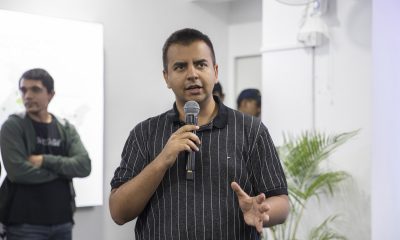Entertainment
How to focus better: 3 strategies for reclaiming your attention

I have a modest dare for you, dear reader: Try to stay on this page for longer than 47 seconds.
That may seem like a ridiculously short and easy period to focus on one task, but studies show that the average time spent on a single screen has shrunk to less than a minute. Indeed, you may feel this intuitively. Has TikTok’s FYP sent you down a Matty Healy rabbit hole today? Have you started an email to a colleague only to get distracted by a Slack conversation? Did you interrupt yourself while doing an important task just to send a timely selfie to your family text thread?
You’re not alone. Even Dr. Gloria Mark, Ph.D., a psychologist who’s studied people’s interaction with computers for more than two decades, has on occasion found herself neck-deep in the anagram word game Pangram when she should’ve been doing something else. It was her research that identified 47 seconds as the average 21st-century attention span on a screen.
In Mark’s new book, Attention Span: A Groundbreaking Way to Restore Balance, Happiness, and Productivity, she not only commiserates with the rest of us, but also offers actionable, science-based strategies for reclaiming your focus. Her advice is particularly refreshing because she doesn’t let tech businesses off the hook for creating products designed to keep people engaged and scrolling. And she doesn’t ignore the workplace grind culture that creates unrealistic expectations for human productivity, either.
In fact, Mark’s approach to focus runs entirely counter to Silicon Valley’s obsession with relentless “productivity” (hello, Elon Musk), and to the corporate handwringing over employees who no longer want to work through the weekend or pull all-nighters.
“We need to reframe our goals in using technology in work to really put well-being first and foremost, as opposed to productivity being at the top,” Mark told me.
What Mark means is that people shouldn’t be exhausted by the end of the day, which is common when they — and their managers — have overestimated their ability to process deluges of information and accomplish a never-ending list of tasks, all in the midst of constant digital temptation to click on a new link. Instead, Mark lays out a “menu” of options to help people take control of their attention, applying it to a rotating combination of complex, creative, and rote activities to help keep the mind alert and fresh. While adopting her strategies requires a fair amount of impulse control, and insight into your boundaries and needs, Mark hopes that these strategies will help people end the day feeling fulfilled and energetic rather than overwhelmed and spent.
When I asked Mark, who is the Chancellor’s Professor of Informatics at the University of California, Irvine, to share her go-to strategies for maintaining her attention span, she named three tactics: imagining your future self, creating blocks of free time during the day, and learning your own rhythm of attention. Keep in mind that her book is filled with numerous suggestions and a lengthy discussion of how we got here in the first place; it’s worth reading Attention Span for that comprehensive view.
1. Imagine your future self.
Sometimes distractions are planned, and welcome. But often people get caught in a current that tosses them to and fro, like mindlessly scrolling social media after looking for specific news and pressing play on one YouTube video only to be drawn in by the next one. To combat this aimless digital wandering, Mark suggests imagining how your future self will feel if the work project with an important deadline is delayed.
Be specific when you envision the consequences. Mark writes in Attention Span that detailed visualizations makes it easier to change behavior. For example, meeting that deadline might now require working late into the night or missing a daily run. Think of the exhaustion or disappointment you will feel as a result.
Mark argues that this exercise in forethought brings awareness to the consequences of current actions and how those will affect your future behavior. If intentionality is practiced enough, Mark says it’ll become second nature to pause before playing an online game and ask how it’ll serve you. If that game gives your mind time to relax and reset, then use it to your advantage by spending a short amount of time on it — and only once or twice rather than throughout the day.
After all, research including Mark’s own studies suggest people need breaks to replenish their energy. But if indulging is an expression of procrastination or unconscious behavior, Mark recommends asking yourself what might be more effective. Perhaps it’s a screen break all together, requesting help from a colleague to complete a challenging task, or a walk outside.
Your future self probably won’t regret making deliberate choices designed to protect and boost your well-being.
2. Create “negative space” in your day.
Mark busts a few myths in her book, including the idea that the human brain can exclusively focus on hard or demanding work for hours at a time. Instead, research shows that people who don’t take sufficient breaks run low on cognitive resources, or mental energy, then start to drift from their goals well before the typical workday is over.
Mark admits that, like many people, she tried to push through these lulls without breaks. A cancer diagnosis more than a decade ago helped her take stock of the cumulative exhaustion she felt and prioritize well-being, not just productivity. Now, one of her main techniques for both improving her focus and taking care of herself is to create “negative space” in her day.
A former artist, Mark uses this term to describe what lies beyond the object of focus, whether that’s a painted image or a sculpture. That space helps frame, often in beautiful ways, what’s being portrayed or depicted. Practically speaking, negative space should be time to “replenish your attentional resources” that’s separate from but supportive of your main goals.
To lengthen and strengthen her attention span, Mark applies this principle by scheduling free time in her day. You might use those periods to walk in nature, practice mindfulness, play Wordle, or garden.
“Negative space is whatever works for you as an individual.”
“Negative space is whatever works for you as an individual,” says Mark.
While some might bemoan such breaks as useless or lazy, Mark says they’re actually essential for reducing stress and generating fresh ideas. Importantly, the more mental energy you have, the easier it will be to resist distractions.
Of course, this strategy requires some measure of control over your schedule. That might not be the case for the employee whose company schedules back-to-back meetings or the warehouse worker who must meet exacting productivity goals. A paltry five-minute break might impulsively lead to scanning Facebook, but Mark says that can amount to multitasking because it means sorting through pieces of information, which in turn can sap your scarce mental energy. Whatever negative space you can claim, try to create a restorative break that leaves you feeling refreshed.
3. Learn your “rhythm of attention.”
One of Attention Span‘s revelations is that people are as likely to interrupt themselves during a task as they are to experience an external distraction, according to Mark’s research. This is for various reasons, among them that people have become accustomed to technological diversions. If all your friends consistently drop emoji in the comments of each other’s TikToks, you probably will, too, and you might just break focus to do exactly that. Human beings are social creatures who sometimes find that mindless digital activities make them feel happy and calm, a reality that needn’t be judged harshly.
At the same time, Mark says that people can learn their own “rhythm of attention” to better understand their peaks and valleys when it comes to focus. Mark says that most people tend to experience an optimal state of focus around 11 a.m. and mid-afternoon, though there are individual differences. The optimal state is when the brain is capable of tackling the hardest, most creative work. Rather than chasing inbox zero during these periods, Mark recommends setting aside that time for the most challenging tasks. As your mental resources start to dwindle, Mark says you should take a break. Again, this helps guard against impulsive time-use choices made in moments of fatigue.
“We can sometimes do more by doing less,” says Mark.
You can complete this 19-question survey to learn more about your circadian rhythm type, which influences periods of focus. Mark also says keeping a weeklong diary to track trends, like peak productivity, waning attention, and refreshing moments of boredom, will provide valuable insight into your rhythm of attention.
While Mark is armed with practical tips, she understands how tough it is to focus these days. She’s not interested in shaming and blaming people who can’t stick with a screen for 47 seconds. She does worry, though, about how tired they might be, because pinging back and forth across the internet is often draining.
“We do it so often and it becomes so habitual,” Mark says of digital distractions. “Exhaustion becomes normal for people — it becomes a state of normality, and that’s really bad.”
-

 Business7 days ago
Business7 days agoHumanoid robots are learning to fall well
-

 Entertainment6 days ago
Entertainment6 days ago2024 summer TV preview: 33 TV shows to watch this summer
-

 Business6 days ago
Business6 days agoGoogle Gemini: Everything you need to know about the new generative AI platform
-

 Business4 days ago
Business4 days agoHaun Ventures is riding the bitcoin high
-

 Entertainment5 days ago
Entertainment5 days ago‘Bridgerton’: Everything you need to remember before Season 3
-

 Entertainment4 days ago
Entertainment4 days agoHands-on with the Claude AI app: It’s pleasant to use, but janky
-

 Entertainment3 days ago
Entertainment3 days ago5 essential gadgets for turning your home into a self-care sanctuary
-

 Business6 days ago
Business6 days agoIndian ride-hailing giant Ola cuts 180 jobs in profitability push




























